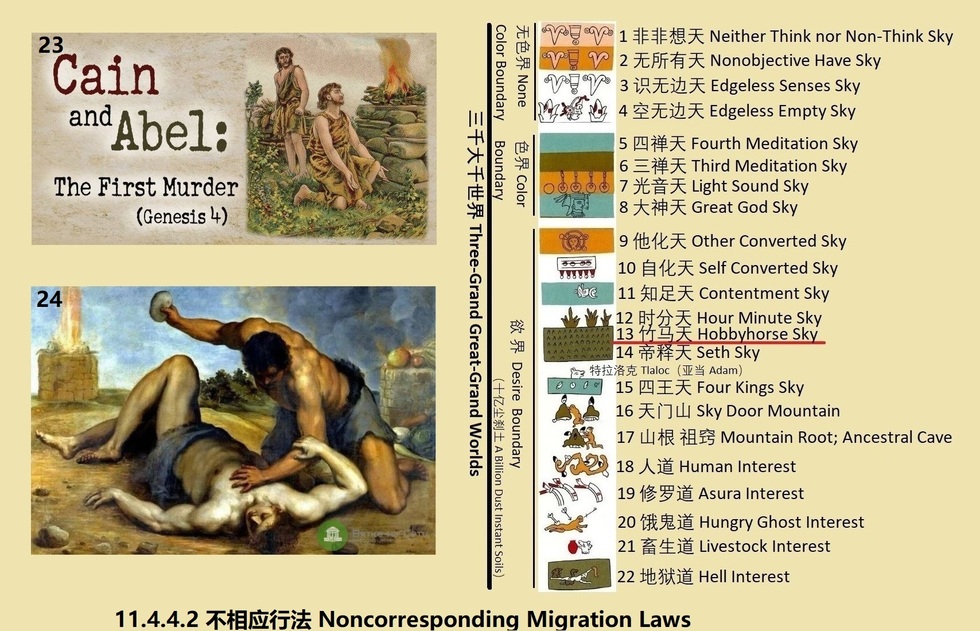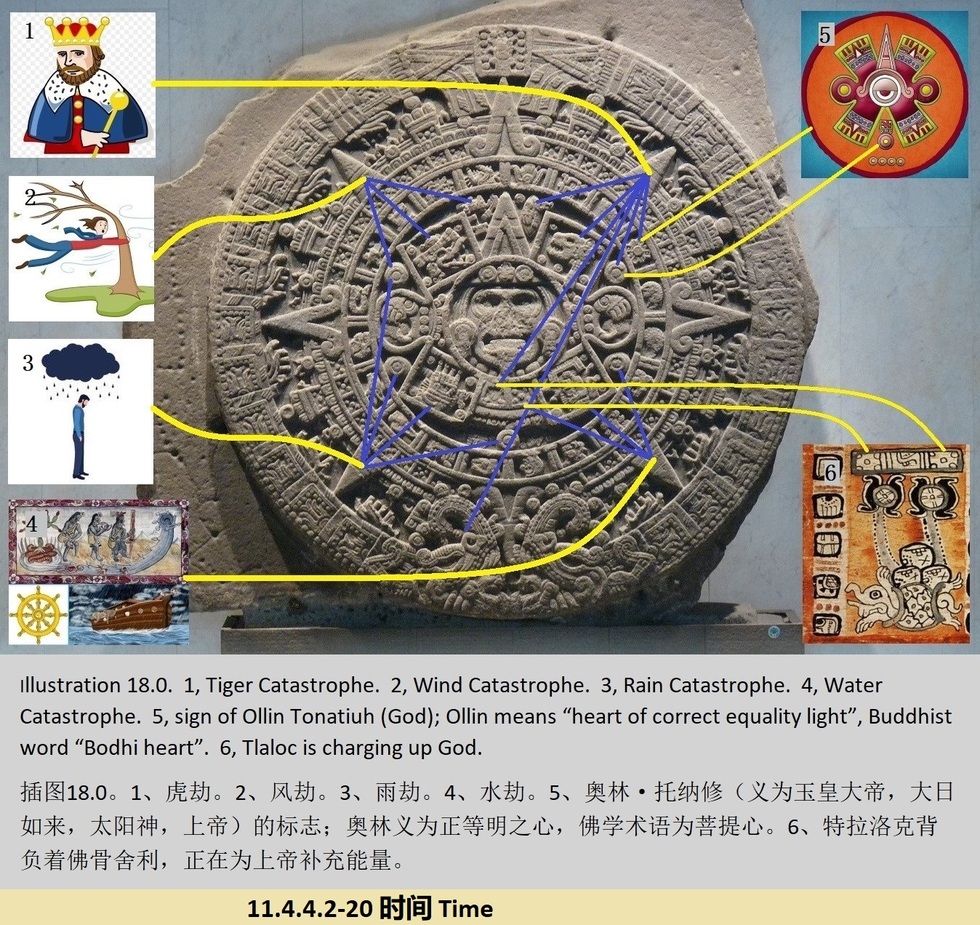11.4.4.2 不相应行法 Noncorresponding Migration Laws
回答: 11.4.4 行蕴 Migration Node 由 Adam_Luyan 于 2024-04-06 14:26
不相应行法从三义得名:一、此位诸法无缘虑作用,故不与心法、心所有法相应;二、此位诸法无质碍作用,故不与色法相应;三、此位诸法是生灭变异之法,也不与无为法相应。
Noncorresponding Migration Law is named from three meanings: first, laws in this faculty have no aggregative mind function, therefore do not correspond to Hearts (cf. section 11.4.5) and Heartland Laws (cf. section 11.4.4.1); second, the laws have not substantial obstructive effects, therefore do not correspond to Color Laws (cf. section 11.4.1); and third, the laws have birth, death, and mutation properties, therefore they are Migration Laws and do not correspond to None-as Laws (cf. section 11.6.4).心不相应行法共有二十四位法:一、得,二、命根,三、众同分,四、异生性,五、无想定,六、灭尽定,七、无想异熟,八 、名身,九、句身,十、文身,十一、生,十二、老,十三、住,十四、无常,十五、流转,十六、定异,十七、相应,十八、势速,十九、次第,二十、时,二十一、方,二十二、数,二十三、和合性,二十四、不和合性。
There are twenty-four Noncorresponding Migration Laws in total: I Gain, II Life Root, III Category, IV Mutant Nature, V Non-think Stillness; VI Extinctive Stillness, VII Non-think Mutation, VIII Name, IX Sentence, X Literature; XI Birth, XII Oldness, XIII Dwell, XIV Impermanence, XV Cycle; XVI Definitional Difference, XVII Correspondence, XVIII Potential Velocity, XIX Sequence, XX Time; XXI Direction, XXII Number, XXIII Combinability, XXIV Non-Combinability. 一)得,基于有情身心的诸法分位,设立三种获得成就:种子成就,自在成就,现行成就。种子成就,某些法虽然不现行,但有潜在势力的功能。自在成就,就是成为独立自主的个体,所需能够自给自足。现行成就,就是种子升起、现行,成为身口意的行为。
I) Gain, based on the juristic differential position in sentient body and mind, three types of attainment are established: seed achievement, self-sufficiency achievement, and performance achievement. Seed achievements are the functions of some laws that are not current but have potential powers. Self-sufficiency achievement means becoming an independent autonomous individual who is self-sufficient in his or her needs. Performance achievement is that seeds are arising presently as bodily orally and intentionally behaviors.得的成就都涉及了种子的概念,什么是种子?本章《生命之树》讲了五位百法,这百法就是一百粒种子,亦作百明法门。但是大乘佛教中有一粒成佛的种子,是大乘佛教的第一特征,也就是能把凡人变成真人的种子,如图11.4.4.2-15中从左向右第二小图所示,即菩提心,亦作愿渡(参见16.1节)。插图1至22是墨西哥画的,所以笔者我认为墨西哥沙门教相当于我们佛教的一乘,即金刚乘。
The Gain attained all involve the concept of seeds, what are seeds? The Tree of Life in this chapter talks about the five faculties of one hundred laws, which are one hundred seeds, also known as the Hundred Light Doors. But in Mahayana Buddhism there is a seed of Buddha, the first characteristic of Mahayana Buddhism, that is, the seed that can turn a mortal into a real human, as shown in the second small illustration from left to right in Fig. 11.4.4.2-15, namely, Bodhi-Heart, also known as Will Ark (see Section 16.1). Illustrations 1 through 22 were drawn by Mexico (i.e., Tlaloc), therefore the author I believe that Mexican Shamanism is equivalent to our Buddhist Oneness Vehicle, also known as Philosopher-Stone Vehicle.
得的圣经用词是凯恩(Cain),也是得义。插图23和24是圣经里的寓言故事,亚当和夏娃的长子凯恩因为妒忌弟弟亚伯(Abel)深受上帝宠爱而杀了他。上帝为此惩罚了凯恩,把他从 “心地法” 流放到了本小节的 “不相应行法” ,还在他的身上做了记号。
The Biblical word for "gain" is Cain, which also means gain. Illustrations 23 and 24 are a Biblical fable in which Cain, the firstborn son of Adam and Eve, killed his brother Abel because he was jealous of his brother's great favor with God. God punished Cain for this by banishing him from the front “Heartland Laws" to the " Noncorresponding Migration Laws" in this subsection and marked his body.亚伯是什么?亚伯的字面意思是自负、能,是人的内在随念自我;华人文化中称作福,亦作大力神,福在佛教中称作儒童(梵语摩纳婆),印度教中作婆罗门,基督教、伊斯兰教、和古埃及文化中称作亚伯,日耳曼文化中作马格尼,墨西哥文化称为灵龙。
What is Abel? The literal meaning of Abel is conceit, able, is the internal along-thoughts ego of a person; in Chinese culture it is Fortune, also known as Great Strength God, Great God Sky (Fig. 11.4.4.2-8) in Buddhism, Brahman in Hinduism, Abel in Christianity, Islam, and Ancient Egyptian cultures, Magni in Germanic cultures, and Quetzalcoatl in Mexican cultures.那亚伯被凯恩杀了,表明了什么?表达了亚伯是可以被杀死的,也就是人不是生来就有自内我(亚伯)这位法的;这是一个根本的哲学问题。比如十八世纪德国的哲学家黑格尔和马克思就曾经辩论过人思维机制里的那个小我(即亚伯)存不存在!结果怎么样?黑格尔错了,马克思说对了:亚伯不存在!这个问题在佛教中是怎么看的?中国佛教认为这个人内部的随念自我是可以被杀死的,但它的害处不大,修习者没必要杀死它。墨西哥沙门教认为杀死灵龙是犯罪。
So, what does the fable of Abel being killed by Cain indicate? It shows that Abel can be killed, i.e., that man is not born with this law of internal along-thoughts ego (Abel); this is a fundamental philosophical issue. For example, the eighteenth-century German philosophers Hegel and Karl Marx once debated the existence or non-existence of the internal along-thoughts ego (i.e., Abel) in the mind mechanism! What was the result? Hegel was wrong and Karl Marx was right: Abel does not exist! How is this question viewed in Buddhism? Chinese Buddhism believe this internal along-thoughts ego can be killed, but it is not so harmful that there is no need for the practitioner to kill it. And it is a crime to kill Quetzalcoatl in Mexican Shamanism.为什么上帝不喜欢凯恩?因为无意识(即神识)只与舍受相应,与得、取、集的性质相违。
Why does God not like Cain? Because the unconscious (i.e., God-sense) corresponds only to the renunciative acceptance, which is contrary to the nature of gain, fetch, and aggregate, etc. 上帝在凯恩的身上做了什么记号?凯恩和亚伯都是法,不是人,所以作者我认为那记号做在了亚当的身上,就是亚当的肉眼通(参见第三章)。
What mark did God put on Cain? Both Cain and Abel are laws, not men, so the author I think that mark was made on Adam, Flesh Eye Through (cf. chapter 3).二)命根,就是有情的寿命;依先业所行,无意识的异熟果恒相续,维持有情身心性命。
II) Life Root is the lifespan of a sentient being; according to behaviors of preceding karma, unconscious variant ripens fruits succeedingly to sustain the physical and mental life.三)众同分,依有情身心相似分位差别,建立同分,即类别,从而形成了众同分。例如,基于众生对根本十戒的违顺,约心、烦恼、和境而辨别分类,遂有六趣:地狱趣、畜生趣、恶鬼趣、修罗趣、人趣、和天趣(插图11.4.4.2-1至22;参见第13章)。
III) Category, based on the differences and similarities of sentient being’s bodily and mentally differentials, same differentials are established, hence categories. For example, based on sentient beings' transgressions of the Ten Fundamental Precepts, they are categorized according to their hearts, annoyances, and environments, and there are six interests: hell-interest, livestock interest, hungry-ghost interest, asura-interest, human-interest, and sky-interest (Illustration 11.4.4.2-1 to 22; Cf. Chapter 13).四)异生性 IV) Mutant Nature异生性是凡夫性的异名,依其种子烦恼和所知而建立。又烦恼和所知妨碍异生出离其本性,所以亦被称作烦恼障和所知障。
Mutant nature is a synonym for mortal nature, is established by its seeds of annoyances and knows. Annoyances and knows hinder mortals from departing from theirs own natures, so the two are also called the annoyance hindrance and know hindrance.烦恼障即是思烦恼,亦作思惑,如贪、嗔、痴、慢、疑、身见、边见、邪见、见取、戒取等。所知障即是见烦恼,亦作见惑,如身见、边见、邪见、见取、戒取、贪、嗔、痴、慢、疑等。
Annoyance hindrances are mean annoyances, also known as mean muddles, such as greed, irritation, ignorance, arrogance, suspicion, Seth view, edge view, heresy, view fetch, precept fetch, and so on. Know hindrances are view annoyances, also known as view muddles, such as Seth view, edge view, heresy, view fetch, precept fetch, greed, irritation, ignorance, arrogance, suspicion, etc. 烦恼障和所知障相互依存,成对儿存在,烦恼由所知而被认知,所知由烦恼而有感,所以此二者具有相同的名和数。烦恼障即是愚痴,能障清净,障涅槃。所知障似智非智,能障智,障觉悟,所以也被称作智障。
Annoyance and know hindrances are interdependent and pairs; Annoyance is recognized by know and know is felt by annoyance, so the two have the same numbers and names. Annoyance hindrances are foolishness, ignorance, which can hinder quietness and nirvana. The know hindrance is like intelligence but not intelligence, and can obstruct intelligence and enlightenment, so it is also called the intelligence hindrance.五)无想定,亦名无心定、长寿天,是佛教中的人生八难之一。谓有异生入于禅定,背想作意,持续强行镇压前意识(亦作夏娃识),日复一日,月复有年。夏娃变得越来越细,终于被折断了;此位禅定修习者就变成了植物人,住于长寿天中等待此无想定异熟果报被消耗尽了,再堕落于人间。定是身心与环境相应而动的一心状态;他都没有心,怎么还被称作定呢?因为想灭为首,身心安和,故被称为无想定。
V) Non-think Stillness, also known as Heartless Stillness and Longevity Sky, is one of the Eight Difficulties of Life in Buddhism. Saying that a mutant who enters meditation and, with the intention to terminate thinks, continues to forcefully suppress the pre-consciousness (aka Eve-sense), day after day, month after year. Eve becomes thinner and thinner and is eventually snapped off; this meditational practitioner becomes a plant man or woman and dwells in the eternal Longevity Sky waiting for the fruit of this Non-think Stillness to be consumed and then falls back to mundane world. Stillness is one-heart state in which the subjective and objective change mutually, the person is even not a heart, how is that called a stillness? Because to terminate thinks is the first thing to go, and the body and mind are at peace, so it is called Non-think Stillness.六)灭尽定,亦作灭彼定,是所有的客观对象都被消灭了的状态,即是插图11.4.4.2-2的无所有天。涅槃是无为法,他或她这样努力地消除客观对象,是有为法,怎么也到了涅盘了呢?她或他在努力作为的过程中,肯定会经历许多挫折和失败,也会有许多灰心丧气的时候,那些灰心丧气与无意识的舍受相应,因此也会增加涅槃出现的概率。
VI) Extinctive End Stillness, also known as Terminating Objective Stillness, is the state in which all objectives are terminated, is nirvana (Fig. 11.4.4.2-2 No Objective Sky). Nirvana is an None-as Law (aka Un-striving Law), so how can he or she also reach Nirvana when he or she makes such an effort to eliminate the objective objects, which is a Have-as Law (aka Striving Law)? In her or his efforts to act, she or he will surely experience many setbacks and failures, and there will be many moments of discouragement and losing heart, those frustrations or losing hearts correspond to unconscious’ renunciative acceptance, therefore increase the probability of the appearance of nirvana.七)无想异熟,也作无想报,禅定中,修习者可能有短暂的无想阶段出现。古德解释,人常有消极或自杀的想法,因此种下了无想的种子。当种子被熏习成熟,就发起现行了。无想异熟是正常的现象,无害。
VII) Non-think Mutant Mature, also known as Non-think Retribution, is a brief phase of no-thought that may occur to the practitioner during meditation. Ancient Virtues explain that people often have negative or suicidal thoughts, thus planting the seed of thoughtlessness. When the seed is ripened by fumigation, it initiates the present. The ripening of thoughtlessness is a normal phenomenon and is harmless.八)名体,诠诸法的自性,如眼、耳、鼻、舌、身等。
VIII) Name Body, explains the self-natures of laws, such as the eyes, ears, nose, tongue, and body, etc.九)句体,诠诸法的差别,如说,“无意识是前意识、意识、和身识等的总根;前意识随着注意于眼识或耳识等识时,转动成为那个识的工作平台,并不断地自我更新。”
IX) Sentence Body, explains the differences of laws, such as the saying, "The unconscious is the total root of the pre-consciousness, intent-sense, and body-sense, etc.; and the pre-consciousness, as it pays attention to a sense such as the eye-sense or the ear-sense, rotates to become the work-platform of that sense, and continually renews itself."十)文体,是字,为名句的所依,如说佛教的宪章为:“诸行无常。诸法无我。涅槃寂静。此三法案为佛所封印,不得更改。”
X) Literal Body, is words, is the basis for names and sentences, such as Buddhist charter: “Migrations are impermanent. Laws have non-I. Nirvana is silent. The three juristic cases are sealed by Buddha, may not be altered."十一)生,在众同分的所有诸行中,从无到有是生。
XI) Birth, is from none to have among migrations in categories.十二)老,在诸行相续的过程中,变坏为老。
XII) Oldness, is deteriorations during the successions of migrations.十三)住,在诸行相续的过程中,随转为住
XIII Dwell, is going along the course of the successions of migrations.十四)无常,在诸行相续的过程中,谢灭为性。
XIV) Impermanence, is fades and extinctions during the successions of migrations.十五)流转 XV) Cycle六趣有情迁流于三界九地之中,不得休息和出离,其因果不出十二有枝:无明、行、识、名色、六处、触、受、爱、取、有、生、老死。
Sentient beings of the Six Interests drift among the three boundaries nine lands, their causes and fruits are among the twelve have branches: Non-Light (Ignorance), Migration, Sense, Name-Color, Six Places, Touch, Acceptance, Love, Fetch, Have, Birth, Old Death.无明义为昏暗、想知道得清楚些,即是无知,从而引发了行枝的运动。此运动,或说由行枝引起的不同,就是识,就是识枝。虽说行枝和识枝同时而有,依据因果,把此二分了先后。就这样,无明枝和行枝引发了后面五枝业果。
Non-Light means dim, and wanting to know, is Ignorance, so that causes the Migration Branch to move. Differences caused by Migration Branch are Senses, are Sense Branch. Although the Migration Branch and Sense Branch come into existence at the same time, based on cause and effect, we divide these two into successive stages. In this way, the Non-light Branch and Migration Branch trigger the next five fruits branches.识、名色、六处、触、和受,五枝被称作五果,义为它们过去业习气果的现行。识枝把信息传播到了名色枝。名即四无色蕴, 即受蕴、想蕴、行蕴、和识蕴,色即色蕴;名和色合在一起就是心,但此时心并不明了,只能说是识正把信息向有情身心扩散。明是明白、内明的光明。当六处收到信息后,由于先业的作用,心开始形成,所以触枝显现了。触(参见11.4.4.1.1节)是遍行心所有法的触枝,有类似于心的功能,可以为心的形成提供动力。当六处明了,受枝就出现了。受枝遇痛则死;若遇到可爱果,受会招引位于三界九地的同类法来摄取可爱果。受枝出现之后,心就变得明了了。一而再,再而三,就引发了后面的孕育三枝。
The five branches of Sense, Name Color, Six Places, Touch, and Acceptance are called Five Fruits, meaning the fruitful performances of their past karmic habits. The Sense branch transmits information to the Name Color Branch. Names are the four colorless nodes, i.e., acceptance node, think node, migration node, and sense node; Color is color node. Name and Color, together are the heart, the flesh body and mind, but at this point, the heart is not illuminated yet; it can only be said that the Senses are spreading the information to the heart, i.e., the flesh body and mind. Illumination is saying of internal light, light of enlightenment. After Six Places (Cf. section 11.3) receive the information, due to karma, heart starts to form, therefore a similar heart, Touch Branch arises. Touch is an Omnipresent Heartland Laws (Cf. section 11.4.4.1.1), can provides heart power during heart formation. After the Six Places are illuminated, the Acceptance Branch appears. When Acceptance Branch encounters pain, it dies; if it encounters lovely fruits, can summon similar laws located in the three boundaries and nine lands. After the emergence of the Acceptance Branch, the heart is fully illuminated. Repeatedly and again, it triggers the later three gestation branches.爱、取、有三枝可以孕育有情,所以被古人称作能生枝。可爱果是异熟果(参见11.6.1节),稀少,像是农业产品,数量有限;而受枝的享受者是等流果。等流果易招,异熟果难求,进而爱生。爱是肥水,能孕育万物,会导致取枝的出现。一而再,再而三,有枝就出现了。什么是有?记忆有,习气有就是有。有枝会导致后面的生枝和老死枝。
The three branches of Love, Fetch, and Have can give birth to interests, and so they were called three gestation branches by Ancient Virtues. Lovable fruits are mutant fruits (cf. Section 11.6.1), scarce, like agricultural products, limited in quantities; and the enjoyers of the Acceptance Branch are equal-stream fruits. Equal-stream fruits are easy to summon, but mutant fruits are hard to get, therefore Love Branch emerges. Love is fertile water, can brew anything, therefore Fetch Branch emerges. More, and again, Have Branch is formed. What is the have? Having memory and having habit are haves. Have Branch can induce later branches of Birth and Old Death.生支和老死枝是被前文的能生支引发的。从无到有为生。衰败为老。灭绝为死。死不一定出现,所以古人用老死来建立此枝。前习气已被孕育了,这出生就是必然的了,随后就有了愁、叹、苦、忧、恼、老死。
The Birth Branch and Old Death Branch are induced by the preceding gestation branches. From nothing to something is birth. Decay or deterioration is old. Extinction is death. Death does not necessarily arise, so the ancients used old-ness and death together to establish this branch. The former habit having been conceived, this Birth is inevitable, followed by sorrow, sighing, bitterness, worry, anguish, and old death.十二有支亦惑业苦三轮来摄取。惑摄无明支、爱支和取支。业摄行支和有支。苦摄识、名色、六处、触、受、生和老死。名色、六处、触、受和识即是有情身心;生死是有情的烦恼。因此苦轮所摄就是苦海中的众生。这样,这十二有支的因果循环,就变成了:众生受苦起惑,因惑起行造业,业又生苦;如是惑业苦循环无尽。
The twelve have branches can also be assimilated by a Wheel composed of Muddle Karma and Bitter. Muddle assimilates Non-light, Love, and Fetch. Karma assimilates Migration and Have. Bitter assimilates Sense, Name Color, Six Places, Touch, Acceptance, Birth, and Old Death. Name Color, Six Places, Touch, Acceptance, and Sense are sentient beings' bodies and minds. Birth and Death are sentient beings' annoyances. Thus, the Bitter takes in all sentient beings in the bitter sea. In this way, the cycle of cause and fruit of these twelve have branches becomes: sentient beings receive bitter to create muddles, and because of muddles they create karma, and karma gives rise to bitter; so, the Wheel of Muddle Karma and Bitter is rolling itself ceaselessly.此十二有枝,古人称作十二缘起,亦作流转真如,是佛教中的七真如之一。契经中是这样描述的:无明望行、行望识、识望名色、名色望六处、六处望触、触望受、受望爱、爱望取、取望有、有望生、生望老死,起愁叹苦忧恼,成大苦具。
These twelve have branches, which the Sanskrit word is pratītya-samutpāda-aṅga, also known as Samsara True-Suchness, is one of the seven kinds of true suchness in Buddhism. The harmonious sutra describes it like this: Non-Light watches Migration, Migration watches Sense, Sense watches Name-Color, Name-Color watches Six Places, Six Places watch Touch, Touch watches Acceptance, Acceptance watches Love, Love watches Fetch, Fetch watches Have, have watches Birth, Birth watches Old Death, arise a great worry, sighing, bitter, gloomy, an annoying aggregate is formed.十六)定异,设立于因果的种种差别相上, 即趣类的特质,是分类的依据。
XVI) Definitional Differences, are established on the various phenomena of cause and fruit, i.e., the traits of interest classes, and are the basis for categorization.十七)相应,于因果法相关的意义上设立,相应即相顺,如前文心所有法于心相应,心生起时,心所有法随心而起。不相应,即彼此互不影响。
XVII Correspondence, is established in the sense of the correlation of cause-and-fruit laws. Correspondence means conformity, such as in the previous section, heartland laws correspond to the heart, and when the heart arises, heartland laws arise with the heart. Not corresponding, i.e., not affecting each other.十八)势速,建立于因果法中的动能势能转化现象,用来表现法的性质,如说贪、嗔、痴有强大的势能,可以孕化其它法的速力。
XVIII) Potential Velocity, is established on the phenomena of kinetic-potential transformation in the law of cause and effect, to be used to express the natures of laws, for example, it is said that greed, irritation, and ignorance have strong potential energies to breed the speedy force of other laws.十九)次第,建立于因果法中的相续发生的现象。
XIX) Sequence, is established on phenomena occurring successively in the law of reason and fruit.
二十)时, 于因果相续流转,时间被设立了。由有因果相续故,若此因果已生已灭,立过去时;若未生,立未来时;若已生未灭,立现在时。又世间义为两时之间,基于流转真如和尘世的形成和衰败,劫历被建立了。一世界有四中劫:成劫、住劫、坏劫、空劫。每个中劫包括二十小劫。一增一减,或说一个流转(即轮回)为一小劫。插图11.4.4.2-20是本书第18章的主题图,中间是墨西哥的劫历石。
XX) Time, in the successive flow of cause and effect, time is set up. By the fact that there is a succession of cause and effect, if this cause and fruit has been born and extinguished, the past time is established; if it has not been born, the future time is established; if it has been born and has not been extinguished, the present time is established. Also, the Mundane-World is defined as between two times and based on the Cycle True-Suchness and the formation and decay of the earthly world, the Catastrophe Calendar is established. There are Four Middle Catastrophes for a Mundane-World, namely, Establishment, Dwell, Damage, and Empty. Each Middle Catastrophe consists of twenty Small Catastrophes. One increase and one decrease, or one Cycle (Samsara) is one Small Catastrophe. Illustration 11.4.4.2-20 is the subject map for Chapter 18 of the book, with the Mexican Catastrophic Calendar Stone in the center.二十一)方,依于形质前后左右而建立,故有东西南北四维上下差别。依此方向,方隅、地方被建立了。一般佛教谈的都是思想意识内世界,即五蕴世间,如圣经的第一章说的就是五蕴世间,述说了一个完整心理机制学寓言。佛教称唯物主义世界为器世间。
XXI) Direction, according to the front and back and the right and left of substantial forms, so there are four dimensions of east, west, south, north, and up and down differences. Based on these directions, places and localities are established. In general, Buddhism talks about the mental inner world, which is called Five Nodes Worlds, such as the first chapter of the Bible, which is about the world of the five nodes, and describes a complete mind mechanical fable. Buddhism calls the material world as Vessel World.二十二)数,依于色心诸行众多品类的一一差别而建立。
XXII) Number, is established according to the one-to-one differences of the many categories among color-heart’s migrations. 二十三)和合,于有因果共相的众缘集会,设立为和合。如识法,因果相续,必借众缘和会:根不坏,境界现前,能生识的作意正起;就说集起的众成员有和合性。
XXIII) Combinability, is established on the aggregative phenomena of cause and effect, if the aggregation is fruitful, we say that those causing factors are combinable. For example, in the case of the sense laws, the succession of cause and fruit must be from aggregation of crowds factors, such as roots are not damaged, environments are presenting at front, senses producer Attention is arising; we say that all elements in the aggregate are combinable.二十四)不和合,与和合性相对立,众缘集会时不产生预期的因果现象,例如美国人向以色列提供武器并高唱自卫,以色列人的战争变得更强烈了;我们就说提供武器,以色列人,和战争,此三没有停火的和合性。
XXIV) Non-Combinability, as opposed to Combinability, does not yield the expected causal phenomena when the congregation is gathered, e.g., when the Americans provide the Israelis with weapons and sing about self-defense loudly, and the Israelis' wars become more intense; we say that there is no cease-fire Combinability between the provision of weapons, the Israelis, and the wars.坛主:Adam_Luyan于2023_10_29 16:07:17编辑
喜欢Adam_Luyan朋友的这个贴子的话, 请点这里投票,“赞”助支持!
请点这里投票,“赞”助支持!


内容来自网友分享,若违规或者侵犯您的权益,请联系我们
所有跟帖: ( 主贴楼主有权删除不文明回复,拉黑不受欢迎的用户 )
打开微信,扫一扫[Scan QR Code]
进入内容页点击屏幕右上分享按钮
进入内容页点击屏幕右上分享按钮
楼主前期社区热帖:
- 金龟婿 3.6.2.10 Golden Turtle Son in Law 04/13/25
- 女娲造人出错了 3.6.2.9 Nuwa Made a Mistake in Creating Humans 04/12/25
- 法师和猎人 3.6.2.8 Juristic Teacher and Hunter 04/11/25
- 小龙女建皇宫 3.1 Little Dragon Girl builds the Palace 04/10/25
- 尧舜禹 15.5.3 Three White-Kings 04/09/25
- 更改行宫的设计 3.6.2.7 Changing the Design of Palace 04/08/25
- 尘香当村长 3.6.2.6 Dust-Incense Becomes Village Chief 04/03/25
- 龙王经 04/02/25
- 3.6.2.4 尘香当官 Dust-Incense as an Official 03/31/25
- 3.6.2.3 汉人的起源 Origin of the Han Chinese 03/30/25
- 3.6.2.2 女娲的后人 Descendants of Nuwa 03/29/25
- 3.6.2 舜禹行宫 Migration Palace of Shun and Yu 03/27/25
- 3.6 劈山救母 Splitting the Mountain to Save Mother 03/25/25
- 心账竹竿 3.1.8 Heart-Account Bamboo 03/23/25
- 娥黄要气死小龙女 3.1.7 Beauty-Yellow Wants to Anger Little Dragon 03/21/25
- 奴隶公司沸腾了 3.1.6 Slave Company is Boiling 03/19/25
- 娥黄给牛郎买工作服 3.1.5 Beauty-Yellow Buys Work Clothes for Cowboy 03/18/25
- 3.1.4 炎帝和二郎神的地产交易 03/16/25
- 姑娘们也兴奋了 3.1.3 Girls are Excited 03/15/25
- 四位家人 2.5 Four Family Members 03/14/25
>>>>查看更多楼主社区动态...



